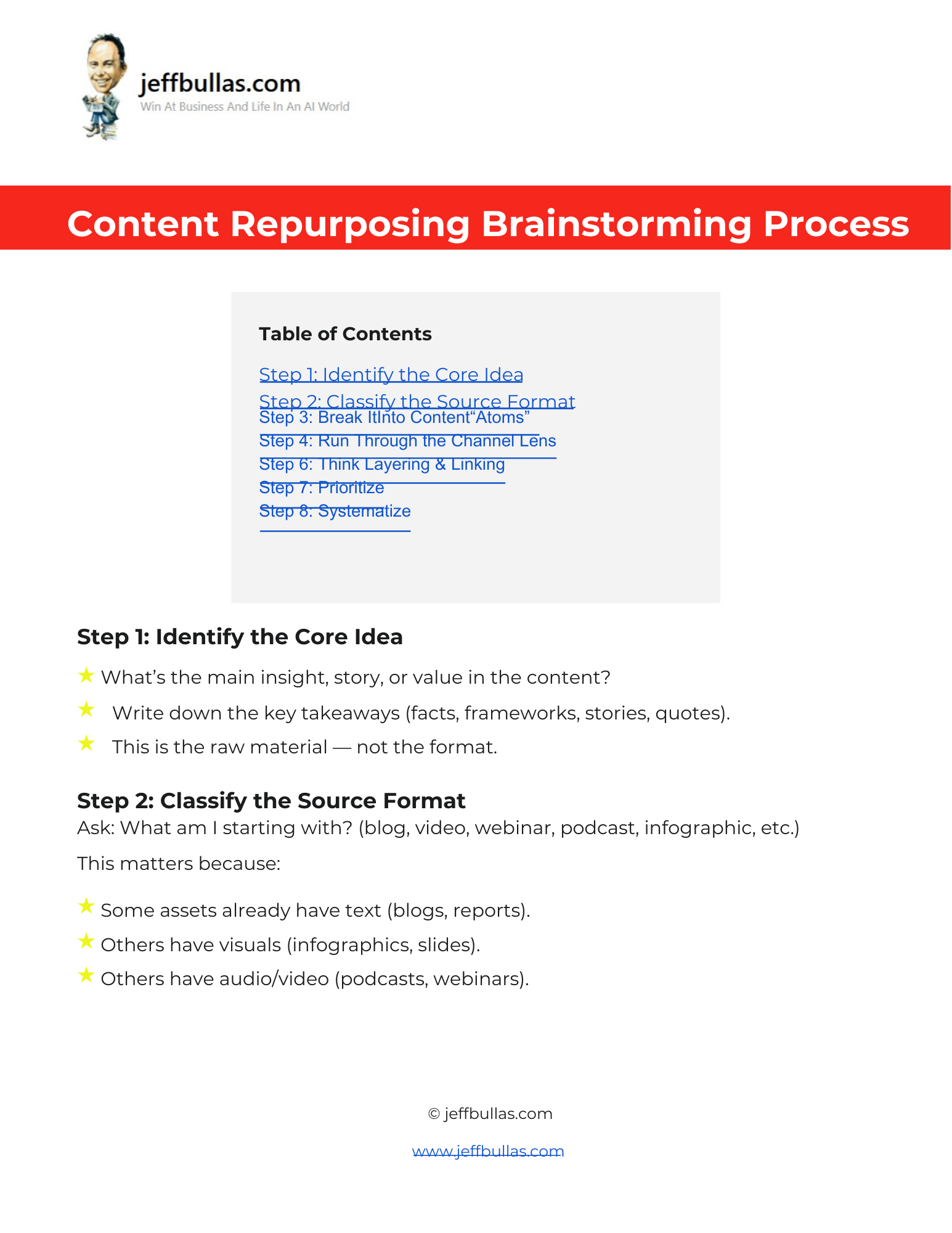
Log in or create a free Jeff Bullas account to download this file.
This resource provides a structured brainstorming process that helps you systematically generate dozens of new content ideas from a single existing asset. It helps you maximize the value and reach of your content by teaching you how to deconstruct, adapt, and link it for every marketing channel.
A Step-by-Step Process for Content Repurposing
This brainstorming process is a practical resource that provides a clear, repeatable framework for repurposing your content. Its main purpose is to move you beyond simple copy-and-pasting and toward a more strategic system for turning one core piece of content into an entire ecosystem of assets.
Identify, classify, and deconstruct your content
The process begins by having you identify the core idea or key takeaways from your source content, which serves as your raw material. Next, you classify the source format you’re starting with (e.g., blog, video, podcast), as this determines what raw materials you already have, such as text, visuals, or audio. From there, you break the content into smaller, reusable “atoms”—like key facts, quotes, frameworks, or stories—which can be repurposed independently.
Brainstorm new formats for different channels
Once you have your content atoms, you run them through the “Channel Lens,” asking how each atom would show up best on each channel. For this step, the process advises you to refer to the Content Placement Cheat Sheet to see the best-suited content types for each platform.
Create a connected content ecosystem
This process encourages you to think about layering and linking your repurposed assets. The goal is to create a content ecosystem rather than standalone fragments. This involves thinking about the primary business goal for each link, whether it is to drive traffic back to a main asset, maximize on-platform engagement, or generate leads by pointing to a gated asset.
Prioritize and systematize your workflow
After brainstorming, you’ll have dozens of ideas. The process guides you to prioritize them based on factors like effort versus impact, channel fit, and your specific business goal (e.g., lead gen, brand awareness). The final step is to systematize this entire workflow by building a repurposing checklist, using a matrix spreadsheet, and assigning owners to different tasks.
How this process helps you apply the information
This resource is structured as a step-by-step process that guides you through a repeatable brainstorming workflow. It ensures you consider all possibilities for your content, helping you move from a raw idea to a prioritized and actionable repurposing plan.
Who is this brainstorming process perfect for?
This process is perfect for content marketers, social media managers, solo entrepreneurs, and marketing teams looking for a structured way to get more value from the content they already have.
Concluding thought
By using this process, you can transform content creation from a constant grind into a more strategic and efficient system that multiplies the impact of your best ideas.
How to Use This
- Make Your Own Editable Copy:
- Open the link provided to access the master Google Doc.
- Once the Google Doc is open, navigate to the menu: File > Make a copy.
- A dialog box will appear. You can rename your copy if you wish and choose where to save it in your personal Google Drive.
- Click “Make a copy.” This action saves an editable version of the document to your Google Drive.
- Using Your Brainstorming Process:
- Choose one piece of “pillar” content you want to repurpose (e.g., a webinar, a detailed blog post).
- Follow the document step-by-step.
- Write down all your ideas as you go through each step.
- Use the “Prioritize” step to select the best ideas to execute first.
- Use the “Systematize” step to create a reusable checklist for future content.
Frequently Asked Questions
What is a content “atom”?
A content “atom” is a small, reusable part of a larger piece of content, such as a key fact, a quote, a framework, or a story, that can be repurposed on its own.
What should I do during the “Channel Lens” step?
In this step, you ask how each content “atom” would best appear on each channel. The document suggests referring to the “Content Placement Cheat Sheet” to help with this.
What business goals should I consider when linking content?
You should consider whether the goal is to drive traffic back to the main asset, maximize on-platform engagement, or generate leads by linking to a gated asset.
How should I prioritize my repurposing ideas?
You should prioritize your ideas by considering the effort required versus the potential impact, how well the idea fits the channel where your audience is, and which ideas align best with your current business goals.
How can I turn this process into a system?
You can systematize this process by creating a repurposing checklist for different content types, using a spreadsheet to map source content to new channels and formats, and assigning ownership of different tasks to team members.
What is the goal of “layering and linking”?
The goal is to create a connected content ecosystem rather than just standalone fragments, where different pieces of content embed or connect to each other.
